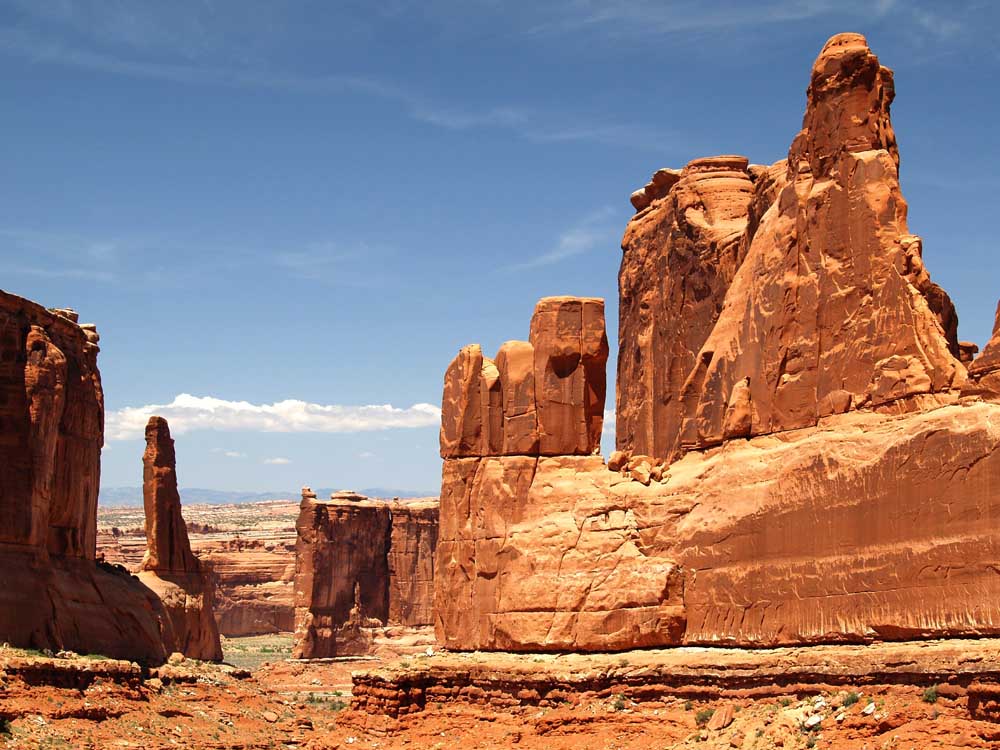Utah’s countless canyons form some of the most amazing landscapes in the world
Published 8:00 am Wednesday, May 1, 2019

- Utah's state and national parks are known for their arches and cliffs. (Courtesy)
“Architects cannot teach nature anything.” Mark Twain
“The finest workers in stone are not copper or steel tools, but the gentle touches of air and water working at their leisure with a liberal allowance of time.” Henry David Thoreau
Trending
Home to five iconic national parks and 44 state parks, Utah offers a rich diversity of outdoor fun. Variations in topography, geology, elevation and precipitation combine to create a patchwork of pinion and ponderosa forests, grasslands, shrubs, canyons and zillions of huge rock formations.
Utah’s distinctive canyon landscape formed more than 300 million years ago when seas covered the area and salt fell to the bottom of the ocean. For thousands of years, water moved along the ocean floor stirring the salt which slowly sanded the rocks, shaping the waterlogged mountains into amazing shapes.
As the water receded, wind and rain continued to chisel the rocks and form a rare sculptured landscape.
Hiking, mountain biking, skiing, river rafting and photography are a few activities for the adventurous. But by far, rock climbing rules.
Arches National Park
Arches National Park has the largest collection of natural arches in the world. The 2,000 arches — including the famous Delicate Arch — range from a 3-foot opening to 306 feet from base to base.
Trending
Towering spires, large boulders delicately balanced on top of worn rock towers, natural gorges and extremely tall narrow fin-shaped canyons also are throughout the park.
If you do not have more than a day to visit, skip seeing Delicate Arch and instead aim for the Landscape Arch. Getting to either one require serious daylong hikes, but at Delicate Arch there are often crowds.
Landscape Arch, which is the length of a football field, looks as if it will fall apart at any moment, is just as impressive as Delicate Arch.
Bryce Canyon National Park
Named after Mormon pioneer Ebenezer Bryce, the park’s unique geology is world renowned. I heard at least eight different languages spoken by fellow visitors while I was at the park.
Numerous viewing decks on canyon mesas look down into bizarre rock formations, such as slotted canyons, openings in the middle of a boulder, narrow sandstone barricades and spires called hoodoos.
Bryce boasts of exceptional air quality ensuing clear panoramic views for almost 200 miles.
The most interesting feature of Bryce Canyon is Inspiration Point, where whimsically arranged rocks, mix with ponderosa pines, fir and spruce trees.
I watched hearty explorers zigzagging among the rock formations or sitting quietly inside a small rock “window” viewing the spectacular nature-made sculptures.
Save a visit to the Inspiration Point viewing deck for the end of the day and watch the sun go down over the canyon. The park offers unparalleled star-gazing tours because of low light pollution.
Canyonlands National Park
Sliced into three areas by the Green and Colorado rivers, each area has spectacular canyons.
I loved the variety of colors in the many layers of rock, starting with a musty white and continuing with rose hues resembling a fancy multi-layered cake.
The Needles area is the highlight of the southern section of Canyonlands. The names of the peaks tell their own story — Devil’s Kitchen, Elephant Hill, Caterpillar Arch and Paul Bunyan’s Potty.
Below the Needles are gigantic plump rocks called “muffin rocks” dotted with natural potholes collecting precious water for Native Americans who lived in the canyon for centuries.
The Maze District is a mass of hoodoos that has been described as a “30 square mile puzzle in sandstone.” Appealing to the more rugged canyon climber or hiker, the Maze ranks as one of the most remote and inaccessible territories in the United States.
Take binoculars to see mountain climbers hanging off the canyon walls.
Zion National Park
Emerald pools, a petrified forest, a desert swamp, springs, waterfalls, hanging gardens, wildflowers, spectacular canyon overlooks — what more could you ask for.
The three scenic drives into the park all offer amzing views.
People often park on the side of the road and walk into the canyons to go bouldering on designated areas. Bouldering is rock climbing on small formations without the use of ropes or harnesses. However, good climbing shoes are recommended.
The most popular non-climbing trail is the Narrows. This 16-mile hike takes at least one day to complete. Sections of the trail literally are in the Virgin River. Wading through the water on a rocky riverbed is a must if you want to see what the Narrows is all about.
At the end of the trail, the canyons close in forming a tall narrow slit.
Be aware of trail elevations. I started a steep trail to the canyon top reaching 8,000 feet, but only made it half way up the narrow trail with sheer drop offs and no guard rails. Struggling to breath and dizzy, I turned around.
My last stop in Utah was a gift store to buy a T-shirt that proudly declares “Utah Rocks.”
For more information about Utah and its national parks, go to us-parks.com, nps.gov and utah.com.



